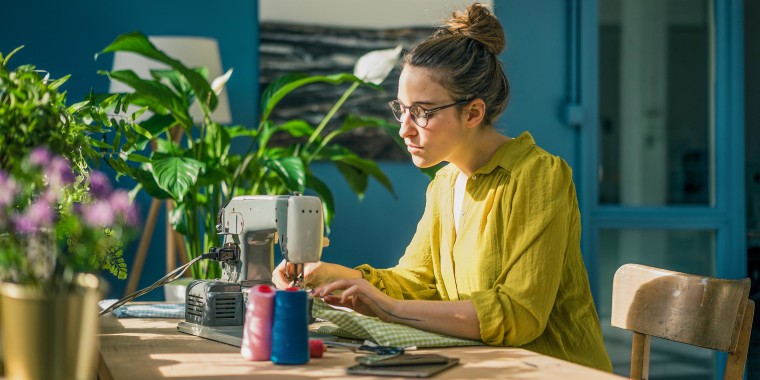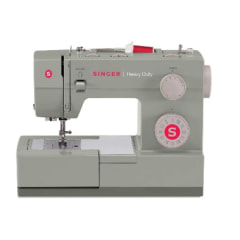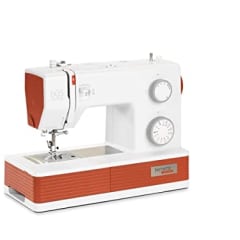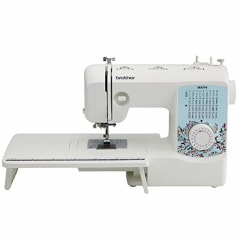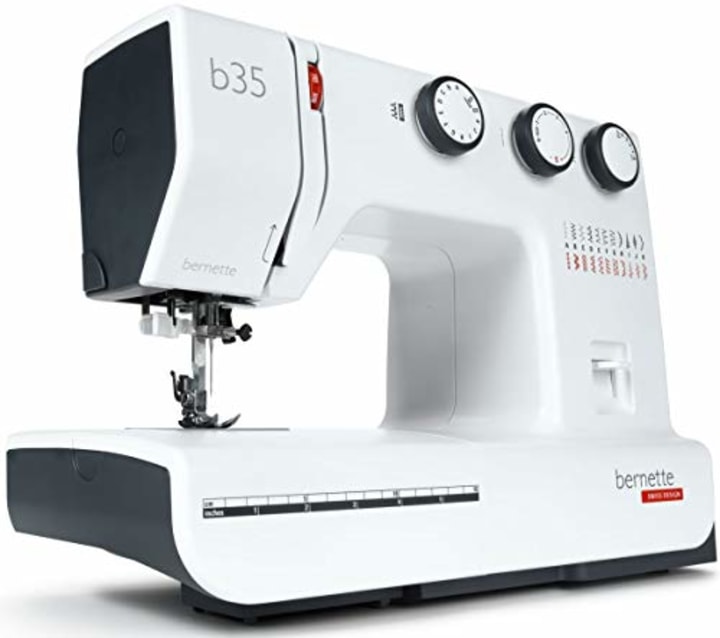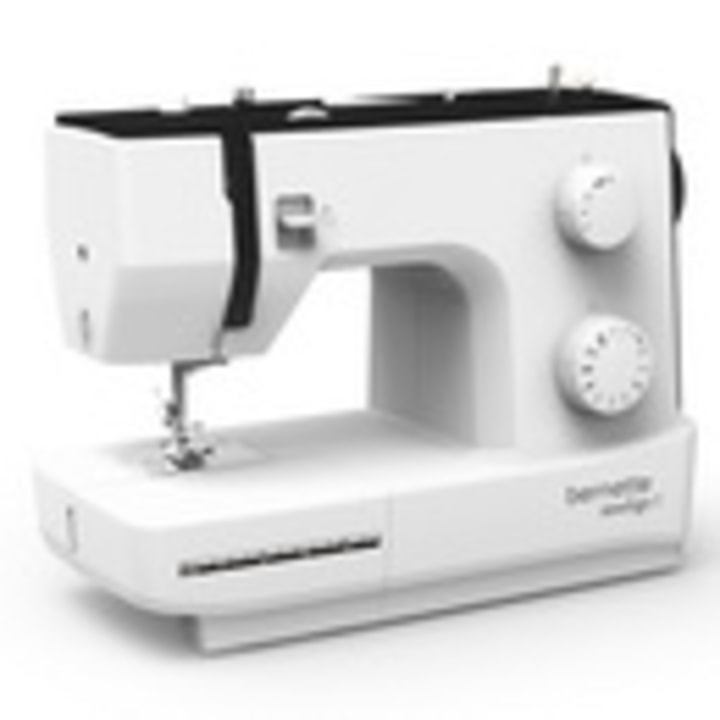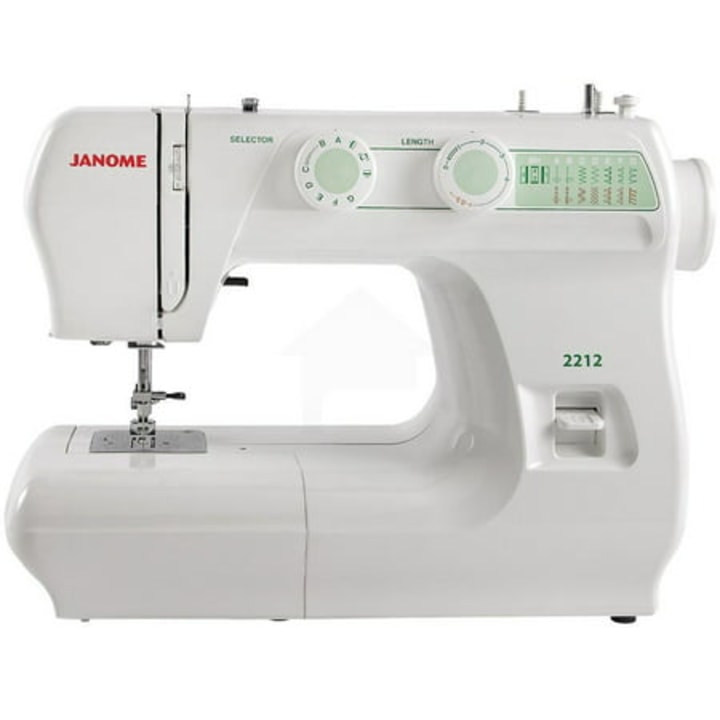According to a Global Arts & Crafts market report, the arts and crafts industry, which includes sewing and fabric, is expected to be valued at over $40 billion by 2025. Sewing is especially popular, thanks in part to popular sites like Etsy and Craftsy, and, of course, social media.
“The DIY movement is huge right now, especially with TikTok and Instagram. It’s a new way of learning,” says Kristine Frailing, owner and creative director of The New York Sewing Center.
“It’s more cost-effective, and people are becoming more aware of the issues of sourcing and sustainability,” she says, adding that there’s also a new trend toward upcycling, or reusing items to make them into new creations.
Sandra Markus, a professor at the Fashion Institute of Technology, says that people use sewing as a means to self expression — plus, it’s more accessible compared to several decades ago. “When I grew up, you went to the store and bought a McCalls [pattern] or a Butterick. Or if you wanted to spend more money, you bought a Vogue. Now there are tons of indie pattern companies offering ways to express your own style,” she says.
To help you hack your style from home, we asked Markus and Frailing for their expert advice on everything new sewers need to know, including what to look for when shopping for a machine and things to do before you start using it.
SKIP AHEAD The best sewing machines for beginners in 2024 | How to shop for a sewing machine
The best sewing machines for beginners in 2024
Our experts say Janome, Singer, Brother and Bernette – the more affordable Bernina line — make the most cost-efficient and reliable sewing machines. Each machine we chose is mechanical, which, according to our experts, is the best type for beginners (more on that below).
Bernette 35 Sewing Machine
“Bernette is the daughter company of Bernina, and their quality matches that of the Berninas,” Frailing says. The machine features 23 stitches, and you can adjust the width, length and pattern of a stitch by turning one of the three separate knobs at the top of the machine, says the brand. If you’re set on a computerized machine, you can opt for the Bernette 37, which includes a few more stitches and can sew wider ones than the 35 model.
Singer Heavy-Duty 4452
This mechanical machine is Markus’ favorite and the one she recommends to all of her students. “It will last forever,” she says. “It has everything you need, and it’s impossible to break.” The 4452 includes an automatic needle threader and has 32 built-in stitches: six basic, seven stretch, 18 decorative and one automatic one-step buttonhole, according to the brand.
Bernette 05 Crafter
The 05 Crafter is the machine for “creative all-rounders,” according to Bernette. Markus also recommends this machine for younger sewers who want to make cut-and-sew knits — ”They will need a toothier machine like this one to handle them,” she adds. This Bernette model can work on fine fabric as well as strong denim, says the brand, and it offers 30 essential stitches, including the one-step buttonhole, as well as a blanket stitch and Lycra stitch for super-stretchy materials. It also has two LED lights to illuminate what you are working on.
Brother XR3774 Sewing Machine
This model from Brother comes with 37 built-in stitches and an LED work light. It also includes a jam-resistant top bobbin to hold a spool of thread and an automatic threader that the brand says is meant to easily push thread through a needle. “This Brother is very useful for someone that is into quilting, because it has a very wide table that most don’t have. I’ve worked with a lot of Brothers — it’s a great beginner brand that will last you a long time, and the price point is wonderful,” says Frailing.
Bernette Sew & Go Sewing Machine
Bernette’s most basic model, the Sew & Go 1, is a great entry-level machine, says Markus. At 15 pounds, it’s also great to travel with or move around the house. It’s one of the more affordable beginner machines on the market at under $200, but since it’s a smaller investment, it has very basic features — just 10 stitches, which can be selected via a simple touch panel or stitch dial, along with attachments to sew on buttons and zippers, according to the brand.
Janome Sewist 721 Sewing Machine
This mechanical machine is on the pricier side, but it’s loaded with helpful features, says Frailing. It has 21 stitches, including stretch stitches and a four-step buttonhole, and is designed to sew up to 850 stitches per minute, according to the brand. It also has bright LED lighting.
Janome 2212 Sewing Machine
This machine is one of Frailing’s favorites. “It’s affordable [at under $200] and has all the features you need to get your sewing hobby started,” she says. “This machine will also last through the years and has the ability to sew lots of different materials and projects.” It includes 12 built-in stitches, a dial for pattern selection and adjustments for the width and length of stitches, according to the brand.
How to shop for a home sewing machine
Here are a few factors our experts say you should consider when shopping for a sewing machine, especially if you’re a beginner:
- Industrial versus home machines: Generally, sewing machines will fall into two broad categories: industrial (commercial) and home (domestic). As the name implies, an industrial sewing machine is meant for professionals in the apparel industry and not for the average beginner. They are fast and precise, and can sew heavier materials such as canvas and leather without a hitch, says Frailing. Some can go well into four-digit price points, like the Consew 206RB-5, which sells for about $1,700. On the other hand, “home sewing machines are the most basic, are beginner-friendly and good to use for almost any project,” says Frailing.
- Where to shop: According to Frailing, you can buy a machine online at Etsy, online or in person at larger retailers like Michaels, Amazon and Walmart, as well as hobby stores. For a lower-cost option, Markus suggests hitting flea markets, church rummage sales and garage sales. “Dealers always have a few second hand ones for sale as well,” she says. If buying one online, she prefers going to a place where you can try them out first.
- Pricing: Home sewing machines can differ dramatically in price. “When buying a sewing machine, one should consider what type of investment they want to make. You can buy a $99 machine and you can buy a $5,000 machine — they both essentially do the same thing,” says Markus, adding that a fair price point for a quality beginner machine is between $200 and $350. “A $79 machine is not really worth buying,” she says. “They get jammed and they can’t really deal with a lot of thicknesses of fabric.”
- Avoiding unnecessary features: As a beginner, Markus also says you should avoid sewing machines with “a whole lot of bells and whistles. You don’t want it highly computerized, because you don’t want to have to spend a lot to fix it. You want to put the money into the body of the machine,” she says. “All you need is one with a great zigzag and straight stitch.”
- Pass on the minis: Mini sewing machines are more affordable than other types, but they should be avoided, Frailing says. “These machines are very small, inexpensive and only for very minor uses, like fixing a hole or something small on the go,” she explains.
Meet our experts
At NBC Select, we work with experts who have specialized knowledge and authority based on relevant training and/or experience. We also take steps to ensure all expert advice and recommendations are made independently and without undisclosed financial conflicts of interest.
- Dr. Sandra Markus is a professor in the Fashion Design department at the Fashion Institute of Technology in New York City. She holds a doctorate in technology from Columbia University.
- Kristine Frailing is the founder and creative director of The New York Sewing Center.
Why trust NBC Select?
Ambar Pardilla and Barbara Booth are former NBC News reporters whose work spans across commerce, business and more. For this piece, they interviewed sewing experts on the best sewing machines for beginners, and what to look for when shopping for a sewing machine of your own.
Ashley Morris is an associate SEO reporter for NBC Select, covering wellness, home and kitchen and more.
Catch up on NBC Select’s in-depth coverage of personal finance, tech and tools, wellness and more, and follow us on Facebook, Instagram, Twitter and TikTok to stay up to date.
